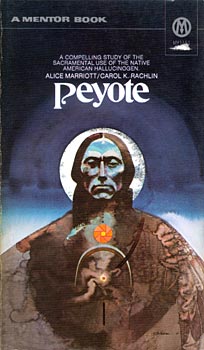
BACK COVER #
Somewhere in the Mexican desert, began the sacramental use of what has been called "The Diabolic Root," "The Key to the Door of Illusion," "The Sacred Plant," and "The Cube that Turns you On, Man...." Its other names are multitude, but the most widely used and best-known is Peyote, from the Aztec word Peyotl.So it is written in this penetrating exploration of the controversial peyote religion, its institutionalization in the form of the Native American church, and its subsequent diffusion among the Indian tribes. The authors, two eminent anthropologists who have participated in peyote ceremonies, describe the effects of the drug, the rituals that surround its use, and the symbolic significance of objects used in the rite. Their account examines peyote's relationship to other facets of Indian culture--witchcraft, metalwork, painting, music--and such fundamental issues as the conflict between church and state. They compare this drug with other hallucinogens, including mescaline, and draw upon their extensive experience to suggest that long-term use may have some deleterious effects.


